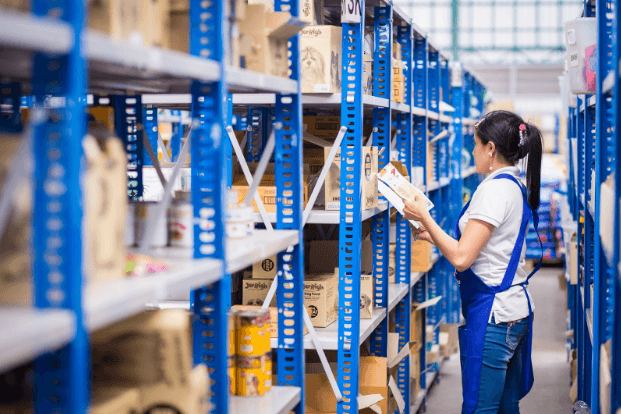What is Store Management?
Material management is only possible if proper records of the stores are maintained. Stores are very important in carrying out day-to-day operations. The objective behind stores is the continuous supply and production of goods and services. Managing the stores ensures that every project, no matter how large or small is properly managed.
Store keeping’s basic function is to receive the materials, recognize, place the same and issue the raw materials on the requisition made by the respective department.
The term “store management” refers to the efficient management of materials. It ensures that all the various activities involved during the process of storekeeping are carried out economically and efficiently.
Definition of Store Management
According to Afford and Beatty, “Store management is that aspect of material control concerned with the physical storage of goods”.
According to Maynard, “Store management is to receive materials, to protect them while in storage from damage and unauthorized removal, to issue the materials in the right quantities, at the right time to the right place and to provide these services promptly and at minimum cost”.
What is the purpose of Store Management?
Objectives of Store Management
The various objectives of store management are as follows:
1) Minimizing Cost of Production:
The store’s primary goal is to produce services at the lowest possible cost by minimizing production costs. The total material cost in production includes the cost of materials, the cost of procurement, and the cost of transporting and transferring materials. The costs of the store include preservation, accounting, insurance, and store equipment. These costs have a direct or indirect effect on the total cost of the product. So, the company is trying to minimize these costs.
2) Maintaining the Worth of Stock:
The primary goal of store management is to keep materials at a minimum on a regular basis in order to make the best use of working capital. It also contributes to lower storage costs. The stock-keeping in the store is completed in a shorter period of time. The storekeeper tries to prevent the inventory from becoming obsolete and also tries to minimize the warehouse time for the stock. The storekeepers work tirelessly to keep the store’s merchandise valuable.
3) Services to Organisation:
The store management helps in providing different types of services to the organization. The service consists of monitoring all the stages, i.e., raw materials and work-in-progress, finished goods, and controlling the scrap.
- There is the proper movement of raw materials, components, tools, equipment, and any other commodities required for the production of products and services.
- They assist with the upkeep of materials, spare parts, and stores as needed.
- They help in maintaining a proper supply of materials at the time of work in progress.
- They assist in obtaining and storing scrap items.
- They help with keeping records of all the receipts, issues, and goods in
4) Establishing Co-ordination with other Departments:
Management relies heavily on coordination. The basic objective of store management is to have proper communication with the material control department. The store manager, for proper functioning, needs to cooperate with another department. They give a continuous flow of information and materials for providing and maintaining services to other departments.
5 ) Advising Materials Manager:
The store plays an important role in material management. Management is reliant on the store’s formulation of various types of investment policies. The store manager needs to have proper knowledge of the store and the store’s items for framing various kinds of policies. Other departments can use this information to keep the stock at the proper quality, quantity, and order level.
How do you maintain the store?
Functions of Stores/Stores Department
Before the material moves into the store, the function of the store begins. In terms of day-to-day operations, the store department must communicate with the user’s office department.
Storekeeping has the following functions:
- Receipt: To receive and account for the inventories that are received.
- Storage: To receive and safely keep the inventory and avoid loss on account of damage, deterioration and pilferage.
- Retrieval: It ensures the materials are easily accessed and space is optimally utilized. It further ensures that the materials are retrieved as and when required.
- Issue: The demand arising on account of the consuming departments is satisfied upon the receipt of the goods.
- Records: To record the receipts and the issues.
- Housekeeping: Emphasis is given on neatness and cleanliness and the same is kept in a manner that the receipts, issue, and storage are satisfactory.
- Surplus Stock: The surplus stock should be properly disposed of.
- Verification: To avoid loss of stock, physical verification should be timely conducted.
- Coordination and Cooperation: To provide for interface with the inspection and the production department
How many types of store management?
Types of Stores
Based upon the classification, a few items discussed below are separately stored as per the scale and the scope of the operations. For example, there are separate stores for waste materials. The same is true for storing specific chemicals and explosives. In other cases, the same items or products may also be stored together. For example, raw materials procured from the outside and produced within the organization can be stored together. Because fixtures and jigs are durable, they can be stored alongside equipment and machinery. Further, the consumables and the maintenance equipment can be stored separately. As a result, one can see that there are no stereotypical rules for managing stores. However, the stores can be classified as follows:
1)Main or Centralized Stores:
This denotes the main or the key store which is responsible for providing supplies to the departments, units or even the sub-stores, which are primarily responsible for issuing goods to the users directly. All the receipts and the issues are managed by a single store located centrally.
2)Branch or Decentralised Stores:
Such stores are often located within the plant itself and are of significant size. This is most appropriate when a single store is unable to meet the needs of plants located in different locations.
3)Central Store with Sub-Stores:
This type of system is found in large factories where there are a number of product lines. Under this arrangement, there exists a main lead store which is further connected to small sub-stores, which are responsible for meeting the demand for a respective production unit that is closely located. The centralized store replenishes all the requirements of the sub-store at periodic intervals.
The storekeeper attached to each of the stores maintains a complete record of the inventory and submits all the records to the head storekeeper. This system is also known as the impressed inventory control system or the periodic store control system.
4)Tool and Miscellaneous Stores:
Such stores generally possess the required tools and the equipment that is required by production and manufacturing units. Taking into account the volume of work, the inventory of tools and equipment should be kept up to date.The store is responsible for meeting all the requirements related to the tools for the various units. The tools are issued first and then the central store or main store makes the supply.
The main store is actually not responsible for making the supplies for the individual departments. Like others, the periodic inventory is accounted for and any deviation is sought out. All the obsolete and defective materials are either replaced or repaired before they are kept on the racks for the purpose of the issue.
5)Warehouses:
This is another term used for going down. They constitute the place where goods are kept and stored either for a short tenure or a long tenure and assist manufacturers as well as traders who intend to store goods for one reason or the other. It is not possible for all to have their own storage units, so, in such cases, the services of warehouses can be taken up. In lieu of a certain rental payment, the goods are stored in reasonably good conditions and efforts are made so that the value of the goods is not lost.
6)Centralised Stores
A centralized store is normally the main store that is responsible for providing supplies for the other stores, the sub stores, and the departments which also issue goods to the users. The material is received and issued from a core location. The departments are not authorized to make purchases on their own. For any requirement, they have to approach the central store and the requisition is fulfilled accordingly.
The following are the primary functions of the centralized store:
I) Receiving the materials, equipment, and tools.
2) Issue of materials to the departments and the branch stores
3) Taking remedial measures for stock replenishment.
A store officer is usually appointed to oversee the operations of the store, with store assistants on hand to handle physical receipts and issues.
A centralized store helps in keeping the inventory in one common place and, moreover, the labor requirement is also reduced to a considerable extent. But, if the departments and the units to whom the supply is to be made are widespread, there can be difficulty in meeting their requirements. Problems with material handling can also arise in the case of centralized stores. Ideally, this concept is best suited for small organizations.
Advantages of Centralised Store
The following are some of the benefits of centralized stores:
- A small location is enough to meet the requirements of different users for different goods.
- As the capacity of the store is limited, less inventory is required. As a result, less money will be invested in inventory.
- The amount of manpower required is reduced.
- Materials can be manipulated a lot better.
These materials are only stored in a small amount of space. This facilitates economical storage. 6) Bulk inventories are avoided.
Disadvantages of Centralised Store
The following are some of the drawbacks of centralized stores:
- This system is not appropriate for big manufacturing concerns.
- The number of people needed to transport the material to various locations is large.
- This system is distinguished by material scarcity and waste.
- If the stores are large, it requires adequate safety measures for the inventory.
- It is hard to manage records.
Decentralized Stores
Those plants and the manufacturing units which are large in size have their own decentralized stores to cater to the needs of the respective plants. It saves time and money and is an easy method to use in decentralized stores. Departments may set up their own stores to fulfill their requirements.
Centralized stores have certain constraints and they are removed under this system. Since setting up different stores requires huge investment and operational costs, this makes the decentralized store system unpopular.
Advantages of Decentralised Store
The following are the benefits of decentralized stores:
- The costs of material handling and associated costs are reduced.
- Bottlenecks have been reduced considerably.
- The damage caused by fire and theft has been reduced.
- Early delivery of materials to the departments. 5) Time and money saved on transportation.
Disadvantages of Decentralised Store
The following are the drawbacks of decentralized stores:
- The inventory cost increases as there is a duplication of inventory.
- Human and manpower resources are underutilized.
- Accounting and clerical functions have also grown in importance.
- There is a problem with managing and coordinating different stores.
What is the need for storage?
Importance of Stores
The system of storekeeping plays an important role in the welfare and profitability of an organization. An efficient store-keeping function is beneficial in the following manner:
1) Minimum Investment:
Because material costs account for a sizable portion of a company’s total production costs, their importance cannot be overstated. An effective store-keeping system facilitates deciding various levels of material-holding, minimum level, maximum level, and re-order level. This, in turn, makes it possible to invest at the optimum level in each category of inventory. The capital saved in this manner is now available for profitable deployment elsewhere.
2)Continuous Flow of Material:
A robust store-keeping system ensures the uninterrupted flow of various materials to the concerned departments engaged in the production process. Situations like reduced production or stoppage of production are totally eliminated and the organization is able to adhere to the production schedule.
3)Protection and Preservation:
A storeroom or warehouse is a place where various materials are physically stored subsequent to their receipt from the suppliers, up to the time they are requisitioned by the concerned production department. The storage period may vary depending upon a number of factors, including the organization’s policy on the matter. The entire function of storekeeping is carried out in an orderly and scientific manner, with the goal of protecting the materials from damage and loss caused by natural (normal deterioration) or unnatural (pilferage, theft, etc.) causes. against deterioration, various preservation techniques, like suitable packaging, application of protective covering, etc., are used. Appropriate security arrangements are put in place to ensure protection against pilferage and theft.
4)Good Quality at Minimum Cost:
In the context of today’s culture of fierce competition among peer business organizations, most companies pursue a two-pronged strategy, namely (i) maintaining product quality and (ii) lowering production costs. An efficient store-keeping system facilitates the implementation of the strategy.
5)Proper Storage for Improved Output:
The importance of keeping everything in its proper place is, of course, paramount.It is helpful for the smooth flow of work. Materials requisitioned from different production departments are delivered promptly.
6)Minimum Wastage:
Maintenance of proper records of stores keeps the store-keeper well informed with regard to the levels of inventories in respect of various materials stored. It removes the need for him to count various items frequently, which not only saves time and energy but also the possibilities of pilferage, theft or other malpractices to a great extent. Wastage is kept to a minimum when materials are being cared for.
7)Co-ordination and Co-operation:
As the store department has to deal with various departments of the organization, it acts as an important link between them. It ensures full cooperation and coordination between them.









